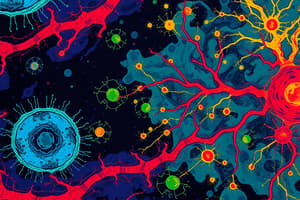Podcast
Questions and Answers
What primarily forms the blood-brain barrier?
What primarily forms the blood-brain barrier?
- Astrocytes alone
- Smooth muscle cells
- Tight junctions of endothelial cells (correct)
- Pericytes and neurons
Which of the following molecules can easily diffuse across the blood-brain barrier?
Which of the following molecules can easily diffuse across the blood-brain barrier?
- Oxygen (correct)
- Glucose
- Polysaccharides
- Proteins
What role do astrocytic endfeet play in the blood-brain barrier?
What role do astrocytic endfeet play in the blood-brain barrier?
- They ensheath the capillaries and support tight junction function. (correct)
- They repair endothelial cells during inflammation.
- They break down large molecules in the blood.
- They transport oxygen across the barrier.
Which cell type is NOT directly involved in forming the blood-brain barrier?
Which cell type is NOT directly involved in forming the blood-brain barrier?
Which physiological condition is likely to increase the permeability of the blood-brain barrier?
Which physiological condition is likely to increase the permeability of the blood-brain barrier?
Which transport mechanism is NOT utilized by the blood-brain barrier?
Which transport mechanism is NOT utilized by the blood-brain barrier?
What is a significant consequence of blood-brain barrier dysfunction?
What is a significant consequence of blood-brain barrier dysfunction?
Which component of the blood-brain barrier provides structural integrity to the blood vessels?
Which component of the blood-brain barrier provides structural integrity to the blood vessels?
Flashcards
Blood-Brain Barrier (BBB)
Blood-Brain Barrier (BBB)
A selective barrier between blood and cerebrospinal fluid in the central nervous system, crucial for maintaining a stable environment for neurons.
BBB Endothelial Cells
BBB Endothelial Cells
Tightly bound cells forming the core of the BBB, restricting passage of harmful substances and regulating what enters the brain tissue.
BBB Tight Junctions
BBB Tight Junctions
Specialized connections between endothelial cells, preventing the passage of large molecules and many water-soluble substances.
BBB Astrocytes
BBB Astrocytes
Signup and view all the flashcards
BBB Permeability
BBB Permeability
Signup and view all the flashcards
BBB Dysfunction causes
BBB Dysfunction causes
Signup and view all the flashcards
BBB Regulation
BBB Regulation
Signup and view all the flashcards
BBB Transport Mechanisms
BBB Transport Mechanisms
Signup and view all the flashcards
Study Notes
Structure and Function
- The blood-brain barrier (BBB) is a highly selective semipermeable border of endothelial cells that separates the circulating blood from the cerebrospinal fluid in the central nervous system (CNS).
- It's crucial for maintaining a stable environment for neuronal function.
- The barrier is primarily formed by tightly joined endothelial cells of brain capillaries.
- These tight junctions prevent the paracellular passage of large molecules and many water-soluble substances.
- Astrocytes, pericytes, and neurons also significantly influence BBB function.
Key Components of the BBB
- Endothelial cells: Form the primary barrier, joined by tight junctions which limit the passage of molecules through the cellular gaps.
- Basement membrane: A sheet of extracellular matrix material lies immediately beneath the endothelial cells bolstering the barrier's function.
- Astrocytic endfeet: Astrocyte processes ensheath the capillaries, further contributing to the tight barrier function. These are in intimate contact with the endothelial elements.
- Pericytes: Wrap around the capillaries and contribute to the structural integrity of the blood vessels.
Regulation of the BBB
- The BBB's permeability is tightly regulated through complex interactions between endothelial cells, astrocytes, and other CNS cells.
- Inflammatory responses and physiological stresses can alter the barrier's permeability.
- Transport mechanisms include transcellular transport and receptor-mediated transport, depending on the substance.
- Active transport systems are vital for delivery of specific nutrients and essential compounds crucial for maintaining the brain's environment.
Permeability of the BBB
- The selectivity of the BBB is vital. Not all substances can freely pass.
- Small, hydrophobic molecules (e.g., oxygen and carbon dioxide) tend to diffuse across easily.
- Large hydrophilic molecules (e.g., proteins) are typically excluded.
- Some substances can exploit transport systems or receptors to cross the barrier.
BBB Dysfunction and its Causes
- BBB disruption is implicated in several neurological disorders.
- Conditions like stroke, trauma, tumors, and infections can compromise the barrier's integrity. This opens the door for molecules that normally stay out to enter the CNS.
- Inflammation leading to leakage and breakdown of the tight junctions, causing swelling and edema is a key aspect of dysfunction.
- Age-related changes and exposure to toxins or other harmful substances can result in long-term damage to the barrier's integrity.
- Certain drugs can increase BBB permeability, which might be therapeutically useful in certain cases.
Clinical Significance
- Understanding BBB properties is crucial for developing therapeutic strategies for brain-related illnesses.
- Delivering treatments directly to the CNS is a major challenge, needing appropriate mechanisms and methods.
- Researchers are examining strategies to enhance drug delivery across the intact BBB.
- Techniques involving nanoparticles and other drug carriers to traverse the barrier are actively researched.
Studying That Suits You
Use AI to generate personalized quizzes and flashcards to suit your learning preferences.
Description
Explore the key components and functions of the blood-brain barrier (BBB) in the central nervous system. Learn about the role of endothelial cells, astrocytes, and the importance of maintaining a stable environment for neuronal function. This quiz covers critical aspects vital for understanding neurological health.




